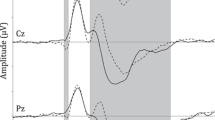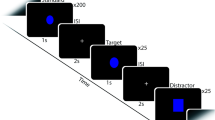Abstract
At present, our understanding of how normal aging affects in vivo brain function is rudimentary. Therefore, the aim of the present study was to investigate age effects on auditory P300 topography. A recently developed dipole source model for P300 distinguishes overlapping P300 subcomponents and enhances reliability as well as validity of the measurement. 67 healthy subjects were examined using the P300 dipole model in addition to the scalp data measurement. The results show that P300 subcomponents reflect functionally different processes concerning age changes of P300 activities. Temporo-parietal P300 is smaller in older subjects, whereas frontal P300 is not attenuated. Age affected both P300 subcomponents' latencies. Therefore, the functionally different alteration of P300 subcomponents might be the reason for P300 topography changes with the P300 maximum more frontally in older age.
Similar content being viewed by others
References
Alexander, J.E., Bauer, L.O., Kuperman, S., Morzorati, S., OConnor, S.J., Rohrbaugh, J., Porjesz, B., Begleiter, H. and Polich, J. Hemispheric differences for P300 amplitude from an auditory oddball task. Int. J. Psychophysiology, 1996, 21: 189-196.
Begleiter, H., Porjesz, B., Reich, T., Edenberg, H.J., Goate, A., Blangero, J., Almasy, L., Foroud, T., Van Eerdewegh, P., Polich, J., Rohrbaugh, J., Kuperman, S., Bauer, L.O., OConnor, S.J., Chorlian, D.B., Li, T.K., Conneally, P.M., Hesselbrock, V., Rice, J.P., Schuckit, M.A., Cloninger, R., Nurnberger, J., Crowe, R. and Bloom, F.E. Quantitative trait loci analysis of human event-related brain potentials: P3 voltage. Electroenceph. Clin. Neurophyiol., 1998, 108: 244-250.
Beck, E.C., Swanson, C. and Dustman, R.E. Long latency components of the visually evoked potential in man: Effects of age. Exp. Aging Res., 1980, 6: 523-545.
Brown, W.S., Marsh, J.T. and LaRue, A. Event-related potentials in psychiatry: differentiating depression and dementia in the elderly. Bull. Los Angeles Neurol. Soc., 1982, 47: 91-107.
Coffey, C.E., Wilkinson, W.E., Parashos, I.A., Soady, S.A.R., Sullivan, R.J., Patterson, L.J., Figiel, G.S., Webb, M.C., Spritzer, C.E. and Djang, W.T. Quantitative cerebral anatomy of the human brain: A cross-sectional study using magnetic resonance imaging. Neurology, 1992, 42: 527-536.
Fabiani, M., Gratton, G., Karis, D. and Donchin, E. Definition, identification, and reliability of measurement of the P300 component of the event-related brain potential. In: P.K. Ackles, J.R. Jennings and M.G.H. Coles (Eds.), Advances in psychophysiology, Plenum, New York, 1987: 1-49.
Fabiani, M. and Friedman, D. Changes in brain activity patterns in aging: the novelty oddball. Psychophysiology, 1995, 32: 579-594.
Falkenstein, M., Hohnsbein, J. and Hoormann, J. Late ERP components, stimulus modality, and choice reaction time. Biol. Psychology, 1993, 35: 201-224.
Frodl-Bauch, T., Gallinat, J., Meisenzahl, E.M., Möller, H.-J., Hegerl, U. P300 subcomponents reflect different aspects of psychopathology in schizophrenia. Biol. Psychiatry, 1999, 45: 116-126.
Goodin, D.S., Squires, K.C. and Starr, A. Long latency event-related components of the auditory evoked potential in dementia. Brain, 1978, 101: 635-648.
Juckel, G., Muller-Schubert, A., Gaebel, W. and Hegerl, U. Residual symptoms and P300 in schizophrenic outpatients. Psychiatry Res., 1996, 65: 23-32.
Halgren, E., Baudena, P., Clarke, J.M., Heit, G., Liegeois, C., Chauvel, P. and Musolino, A. Intracerebral potentials to rare target and distractor auditory and visual stimuli. I. Superior temporal plane and parietal lobe. Electroenceph. Clin. Neurophysiol., 1995, 94: 191-220.
Hegerl, U., Juckel, G., Muller-Schubert, A., Pietzcker, A. and Gaebel, W. Schizophrenics with small P300: a subgroup with a neurodevelopmental disturbance and a high risk for tardive dyskinesia? Acta. Psychiatr. Scand., 1995, 91: 120-125.
Hegerl, U. and Frodl-Bauch, T. Dipole source analysis of P300 component of the auditory evoked potential: a methodological advance? Psychiatry Research: Neuroim, 1997, 74: 109-118.
Hill, S.Y., Steinhauer, S., Park, J. and Zubin, J. Event-related potential characteristics in children of alcoholics from high density families. Alcohol Clin. Exp. Res., 1990, 14: 6-16.
Holinger, D., Faux, S., Shenton, M., Sokol, N., Seidman, L., Green, A. and McCarley, R. Reversed temporal region asymmetries of P300 topography in left and right-handed schizophrenic subjects. Electroenceph. Clin. Neurophysiol., 1992, 84: 532-537.
Ito, J., Yamao, S., Fukuda, H., Mimori, Y. and Nakamura, S. The P300 event-related potentials in dementia of the Alzheimer type. Correlations between P300 and monoamine metabolites. Electroenceph. Clin. Neurophysiol., 1990, 77: 174-178.
Karniski, W. and Blair, R.C. Topographical and temporal stability of the P300. Electroenceph. Clin. Neurophysiol., 1989, 72: 373-383.
Kügler, C.F., Taghavy, A. and Platt, D. The event-related P300 potential analysis of cognitive human brain aging: a review. Gerontology, 1993, 39: 280-303.
Loessner, A., Alavi, A., Lewandrowski, K.-U., Mozley, D., Souder, E. and Gur, R. Regional cerebral function determined by FDG-PET in healthy volunteers: Normal patterns and change with age. J. Nucl. Med., 1995, 36: 1141-1149.
Murphy, D.G., DeCarli, C., Schapiro, M., Rapoport, S. and Horwitz, B. Age-related differences in volumes of subcortical nuclei, brain matter, and cerebrospinal fluid in healthy men as measured with magnetic resonance imaging. Arch. Neurol., 1992, 49: 839-845.
Naumann, E., Huber, C., Maier, S., Plihal, W., Wustmans, A., Dietrich, O. and Bartussek, D. The scalp topography of P300 in the visual and auditory modalities: A comparison of three normalization methods and the control of statistical type II error. Electroenceph. Clin. Neurophysiol., 1992, 83: 300-318.
Oldfield, R.C. The assessment and analysis of handedness: the Edingburgh inventory. Neuropsychologia, 1971, 9: 97-113.
Pfefferbaum, A., Ford, J.M. and Kraemer, H.C. Clinical utility of long latency ćognitivé event-related potentials (P3): the cons. Electroenceph. Clin. Neurophysiol., 1990, 76: 6-12.
Polich, J. and Kok, A. Cognitive and biological determinants of P300: an integrative review. Biol Psychol., 1995, 41: 103-146.
Polich, J. Meta-analysis of P300 normative aging studies. Psychophysiology, 1996, 33: 334-353.
Porjesz, B., Begleiter, H., Litke, A., Bauer, L.O., Kuperman, S., OConnor, S.J. and Rohrbaugh, J. Visual P3 as a potential phenotypic marker for alcoholism: Evidence from the COGA national project. In: C. Ogura, Y. Koga, and M. Shimokochi (Eds.), Recent advances in event-related brain potential research. Elsevier, Amsterdam, 1996: 539-549.
Roth, W.T., Kopell, J.R., Tinklenberg, J.R., Huntsberger, G.E. and Kraemer, H.C. Reliability of the contigent negative variation and the auditory evoked potential. Electroenceph. Clin. Neurophysiol., 1975, 38: 45-50.
Ruchkin, D.S., Sutton, S. and Mahaffey, D. Functional differences between members of the P300 complex: P3e and P3b. Psychophysiology, 1987, 24: 87-103.
Scherg, M. and von Cramon, D. Evoked dipole source potentials of the human auditory cortex. Electroenceph. Clin. Neurophysiol., 1986, 65: 344-360.
Scherg, M. and Picton, T.W. Separation and identification of event-related potential components by brain electrical source analysis: In: C.H.M. Brunia, G. Mulder and M.N. Verbraten (Eds.) EEG Suppl., 1991, 42: 24-37.
Segalowitz, S.J. and Barnes, K.L. The reliability of ERP components in the auditory oddball paradigm. Psychophysiology, 1993, 30: 451-459.
Shefer, V.F. Absolute numbers of neurons and thickness of cerebral cortex during aging, senile and vascular dementia, and Pickś and Alzheimerś diseases. Neurosci. Behav. Physiol., 1972, 6: 319-324.
Sklare, D.A. and Lynn, G.E. Latency of the P3 event-related potential: normative aspects and within subject variability. Electroenceph. Clin. Neurophysiol., 1984, 59: 420-424.
Squires, N.K., Squires, K.C. and Hillyard, S.A. Two varieties of long-latency positive waves evoked by unpredictable auditory stimuli in man. Electroenceph. Clin. Neurophysiol., 1975, 38: 387-401.
Strik, W.K., Dierks, T., Franzek, E., Maurer, K. and Beckmann, H. Differences in P300 amplitudes and topography between cycloid psychosis and schizophrenia in Leonhard's classification. Acta Psychiatr. Scand., 1993, 87: 179-183.
Sutton, S., Braren, M., Zubin, J. and John, E.R. Evoked-potential correlates of stimulus uncertainty. Science, 1965, 150: 1187-1188.
Takada, H., Nagata, K., Hirata, Y., Satoh, Y., Watahiki, Y., Sugawara, J., Yokoyama, E., Kondoh, Y., Shishido, F., Inugami, A., Fujita, H., Ogawa, T., Murakami, M., Iida, H. and Kanno, I. Age-related decline of cerebral oxygen metabolism in normal population detected with positron emission tomography. Neurol. Res., 1992, 14(Suppl 2): 128-131.
Terry, R.D., Peck, A., DeTereas, R., Schechter, R. and Horoupian, D.S. Some morphometric aspects of the brain in senile dementia of the Alzheimer type. Ann. Neurol., 1981, 10: 184-192.
Author information
Authors and Affiliations
Rights and permissions
About this article
Cite this article
Frodl, T., Juckel, G., Gallinat, J. et al. Dipole Localization of P300 and Normal Aging. Brain Topogr 13, 3–9 (2000). https://doi.org/10.1023/A:1007831017318
Issue Date:
DOI: https://doi.org/10.1023/A:1007831017318




